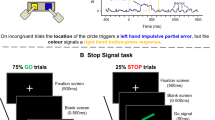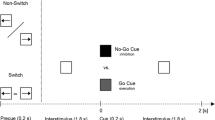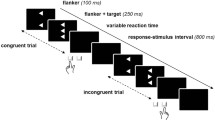Abstract
Fallibility is inherent in human cognition and so a system that will monitor performance is indispensable. While behavioral evidence for such a system derives from the finding that subjects slow down after trials that are likely to produce errors, the neural and behavioral characterization that enables such control is incomplete. Here, we report a specific role for dopamine/basal ganglia in response conflict by accessing deficits in performance monitoring in patients with Parkinson’s disease. To characterize such a deficit, we used a modification of the oculomotor countermanding task to show that slowing down of responses that generate robust response conflict, and not post-error per se, is deficient in Parkinson’s disease patients. Poor performance adjustment could be either due to impaired ability to slow RT subsequent to conflicts or due to impaired response conflict recognition. If the latter hypothesis was true, then PD subjects should show evidence of impaired error detection/correction, which was found to be the case. These results make a strong case for impaired performance monitoring in Parkinson’s patients.




Similar content being viewed by others
References
Angel RW (1971) L-dopa and error correction time in Parkinson’s disease. Neurology 21:1255–1260
Botvinick MM, Braver TS, Barch DM, Carter CS, Cohen JD (2001) Conflict monitoring and cognitive control. Pschyol Rev 108:624–652
Boucher L, Palmeri TJ, Logan GD, Schall JD (2007) Inhibitory control in mind and brain an interactive race model of countermanding saccades. Psychol Rev 114:376–397
Bradley VA, Welch JL, Dick DJ (1989) Visuospatial working memory in Parkinson’s disease. J Neurol Neurosurg Psychiatry 52:1228–1235
Briand KA, Strallow D, Hening W, Poizner H, Sereno AB (1999) Control of voluntary and reflexive saccades in Parkinson’s disease. Exp Brain Res 129:38–48
Camalier CR, Gotlier A, Murthy A, Thompson KG, Logan GD, Palmeri TJ, Schall JD (2007) Dynamics of saccade target selection: race model analysis of double-step saccade and search-step saccade production in human and macaque. Vis Res 47:2187–2211
Chan F, Armstrong IT, Pari G, Riopelle RJ, Munoz DP (2005) Deficits in saccadic eye-movement control in Parkinson’s disease. Neuropsychologia 43:784–796
Dehaene S, Posner MI, Tucker DM (1994) Localisation of a neural system for error detection and compensation. Psychol Sci 5:303–305
Dehaene S, Kerzberg M, Changeux JP (1998) A neuronal model of a global workspace in effortful cognitive tasks. PNAS 95:14529–14534
Divac I, Rosvild HE, Szwarcbart MK (1967) Behavioral effects of selective ablation of caudate nucles. J Comp Physiol Psychol 63:184–190
Dum RP, Strick PL (1993) Cingulate motor areas. In: Vogt BA, Gabriel M (eds) Neurobiology of cingulate cortex and limbic thalamus, 1st edn. Birkhäuser, Boston, pp 415–441
Emeric EE, Brown JW, Carpenter RH, Hanes DP, Harris R, Logan GD, Mashru RN, Pare M, Pouget P, Stuphorn V, Taylor TL, Schall JD (2007) Influence of history on saccade countermanding performance in humans and macaque monkeys. Vis Res 47:35–49
Falkenstein M, Hielscher H, Dziobek I, Schwarzenau P, Hoormann J, Sunderman B, Hohnsbein J (2001) Action monitoring, error detection and the basal ganglia: An ERP study. Neuro Report 12:157–161
Gehring WJ, Goss B, Coles MGH, Meyer DE, Donchin E (1993) A neural system for error detection and compensation. Psychol Sci 4:385–390
Hanes DP, Patterson WF II, Schall JD (1998) Role of frontal eye fields in countermanding saccades: visual, movement and fixation activity. J Neurophysiol 79:817–834
Hatanaka N, Tokuno H, Hamada I, Inase M, Ito Y, Imanishi M, Hasegawa N, Akazawa T, Nambu A, Takada M (2003) Thalamocortical and intracortical connections of monkey cingulate motor areas. J Comp Neurol 462:121–138
Hoehn MM, Yahr MD (1967) Parkinsonism: onset, progression and mortality. Neurology 17:427–442
Holroyd CB, Coles MG (2002) The neural basis of human error processing: reinforcement learning, dopamine and error-related negativity. Psychol Rev 109:679–709
Holroyd CB, Praamstra P, Plat E, Coles MG (2002) Spared error-related potentials in mild to moderate parkinson’s disease. Neuropsychologia 40:2116–2124
Ito J, Kitagawa J (2006) Performance monitoring and error processing during a lexical decision task in patients with Parkinson’s disease. J Geriatr Psychiatry Neurol 19:46–54
Joti P, Kulashekhar S, Behari M, Murthy A (2007) Impaired inhibitory control in patients with Parkinson’s disease. Exp Brain Res 177:447–457
Kapoor V, Murthy A (2008) Covert inhibition potentiates online control in a double-step task. J Vis 8:1–16
Kingstone A, Klein R, Morein-Zamir S, Hunt A, Fisk J, Maxner C (2002) Orienting attention in aging and Parkinson’s disease: distinguishing models of control. J Clin Exp Neuropsychol 24:951–967
Lewis SZ, Slabosz A, Robbins TW, Barker RA, Owen AM (2005) Dopaminergic basis for deficits in working memory but not attentional set-shifting in Parkinson’s disease. Neuropsychologia 43:823–832
Lo CC, Wang XJ (2006) Cortico-basal ganglia circuit mechanism for a decision threshold in reaction time tasks. Nat Neurosci 9:953–963
Logan GD (1985) Executive control of thought and action. Acta Psychol 60:193–210
Murthy A, Ray S, Shorter SM, Schall JD, Thompson KG (2009) Neural control of visual search by frontal eye field: effects of unexpected target displacement on visual selection and saccade preparation. J Neurophysiol 101:2485–2507
Ottes FP, Van Gisbergen JA, Eggermont JJ (1984) Metrics of saccade responses to visual double stimuli: two different modes. Vis Res 24:1169–1179
Owen AM (2004) Cognitive dysfunction in Parkinson’s disease: the role of frontostriatal circuitry. Neuroscientist 10:525–537
Rabbitt PMA (1966) Errors and error-correction in choice response tasks. J Exp Psychol 71:264–272
Rabbitt PMA (1968) Three kinds of error signaling responses in serial choice task. Q J Exp Psychol 20:179–188
Ramakrishnan A, Chokandre S, Murthy A (2010) Voluntary control of multi-gaze shifts during movement preparation and execution. J Neurophysiol 103:2400–2416
Redgrave K (1999) The basal ganglia: a vertebrate solution to the selection problem? Neurosci 89:1009–1023
Ridderinkhof KR, Ullsperger M, Crone EA, Nieuwenhuis S (2004) The role of the medial frontal cortex in cognitive control. Science 306:443–447
Roll A, Wierzbicka M, Wolf W (1996) The ‘gap paradigm’ leads to express-like saccadic reaction times in Parkinson’s disease. Exp Brain Res 111:131–138
Schall JD (2001) Neural basis of deciding, choosing and acting. Nat Rev Neurosci 2:33–42
Schultz W (1997) A neural substrate of prediction and reward. Science 14:1593–1599
Schultz W, Romo R (1992) Role of primate basal ganglia and frontal cortex in the internal generation of movements. I. Preparatory activity in the anterior striatum. Exp Brain Res 91:363–384
Shallice T (1988) From neuropsychology to mental structure. Cambridge University Press, Cambridge
Shallice T, Burgess P (1996) The domain of supervisory processes and temporal organization of behaviour. Philos Trans R Soc Lond B Biol Sci 351:1405–1411
Stemmer B, Segalowitz SJ, Dywan J, Panisset M, Melmed C (2007) The error negativity in medicated and non-medicated patients with Parkinson’s Disease. Clin Neurophysiol 118:1223–1229
Stuphorn V, Schall JD (2002) Neuronal control and monitoring of initiation of movements. Muscle Nerve 26:326–339
Stuss DT, Benson DF (1986) The frontal lobes. Raven Press, New York
Swick D, Turken AU (2002) Dissociation between conflict detection and error monitoring in the human anterior cingulated cortex. Proc Natl Acad Sci USA 99:16354–16359
Ullsperger M, von Cramon DY (2004) Subprocesses of performance monitoring: a dissociation of error processing and response competition revealed by event-related fMRI and ERPs. Neuroimage 14:1387–1401
Willemssen R, Muller T, Schwarz M, Falkenstein M, Beste C (2009) Response monitoring in de novo patients with Parkinson’s disease. Plos One 4:e4898
Williams ZM, Bush G, Rauch SL, Cosgrove GR, Eskander EN (2004) Human anterior cingulate neurons and the integration of monetary reward with motor responses. Nat Neurosci 7:1370–1375
Acknowledgments
We thank Jitender Ahlawat for manuscript preparation. This work was supported by grants from the Department of Science and Technology (DST) and the Department of Biotechnology (DBT), Government of India.
Author information
Authors and Affiliations
Corresponding author
Rights and permissions
About this article
Cite this article
Farooqui, A.A., Bhutani, N., Kulashekhar, S. et al. Impaired conflict monitoring in Parkinson’s disease patients during an oculomotor redirect task. Exp Brain Res 208, 1–10 (2011). https://doi.org/10.1007/s00221-010-2432-y
Received:
Accepted:
Published:
Issue Date:
DOI: https://doi.org/10.1007/s00221-010-2432-y




